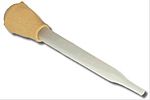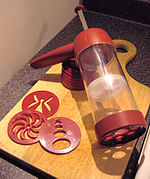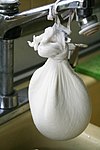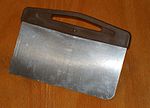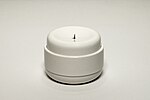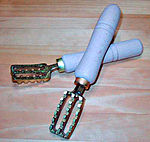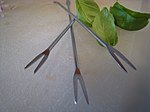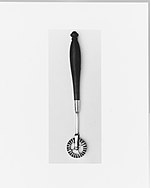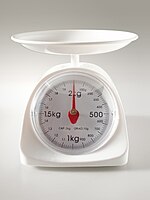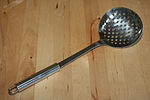
A kitchen is a room or part of a room used for cooking and food preparation in a dwelling or in a commercial establishment. A modern middle-class residential kitchen is typically equipped with a stove, a sink with hot and cold running water, a refrigerator, and worktops and kitchen cabinets arranged according to a modular design. Many households have a microwave oven, a dishwasher, and other electric appliances. The main functions of a kitchen are to store, prepare and cook food. The room or area may also be used for dining, entertaining and laundry. The design and construction of kitchens is a huge market all over the world.

A cookbook or cookery book is a kitchen reference containing recipes.
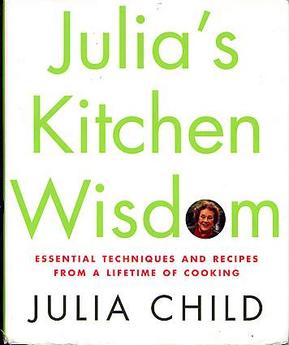
Julia's Kitchen Wisdom is the final cookbook authored by chef and television personality Julia Child. Co-authored by David Nussbaum and edited by Judith Jones, the book covers basic cooking principles and techniques and was designed to serve as a reference point for amateur cooks. Julia's Kitchen Wisdom was the 17th book written by Child and gained widespread popularity following the release of the 2009 film, 'Julie and Julia'.

Kitchenware are the tools, utensils, appliances, dishes, and cookware used in food preparation, or the serving of food. Kitchenware can also be used in order to hold or store food before or after preparation.
Sir Terence Orby Conran was a British designer, restaurateur, retailer and writer. He founded the Design Museum in Shad Thames, London in 1989. The British designer Thomas Heatherwick said that Conran "moved Britain forward to make it an influence around the world." Edward Barber, from the British design team Barber & Osgerby, described Conran as "the most passionate man in Britain when it comes to design, and his central idea has always been 'Design is there to improve your life.'" The satirist Craig Brown once joked that before Conran "there were no chairs and no France."
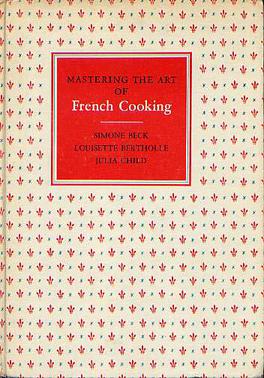
Mastering the Art of French Cooking is a two-volume French cookbook written by Simone Beck and Louisette Bertholle, both from France, and Julia Child, who was from the United States. The book was written for the American market and published by Knopf in 1961 and 1970.

John Douglas Torode is an Australian-British celebrity chef and TV presenter. He moved to the UK in the 1990s and began working at Conran Group's restaurants. After first appearing on television on ITV's This Morning, he started presenting a revamped MasterChef on BBC One in 2005. He is a restaurateur; former owner of the Luxe and a second restaurant, Smiths of Smithfield. He has also written a number of cookbooks, including writing some with fellow MasterChef presenter and judge, Gregg Wallace.

The Boston Cooking-School Cook Book (1896) by Fannie Farmer is a 19th-century general reference cookbook which is still available both in reprint and in updated form. It was particularly notable for a more rigorous approach to recipe writing than had been common up to that point.
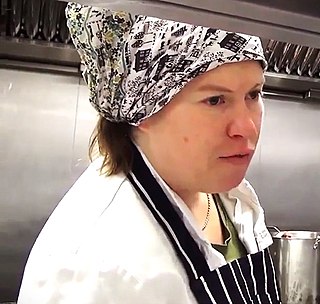
Allegra Sarah Bazzett McEvedy MBE is an English chef, broadcaster and writer.

A kitchen utensil is a small hand-held tool used for food preparation. Common kitchen tasks include cutting food items to size, heating food on an open fire or on a stove, baking, grinding, mixing, blending, and measuring; different utensils are made for each task. A general purpose utensil such as a chef's knife may be used for a variety of foods; other kitchen utensils are highly specialized and may be used only in connection with preparation of a particular type of food, such as an egg separator or an apple corer. Some specialized utensils are used when an operation is to be repeated many times, or when the cook has limited dexterity or mobility. The number of utensils in a household kitchen varies with time and the style of cooking.
Anne Mendelson is an American food journalist and culinary historian. She lives in Hudson County, New Jersey, with her cat, and believes that the medley of ethnic cooking in her neighborhood, combined with memories from her childhood in rural Pennsylvania, provided inspiration for her writing.
Simon Charles Hopkinson is an English food writer, critic and former chef. He published his first cookbook, Roast Chicken and Other Stories, in 1994.
Elizabeth David, the British cookery writer, published eight books in the 34 years between 1950 and 1984; the last was issued eight years before her death. After David's death, her literary executor, Jill Norman, supervised the publication of eight more books, drawing on David's unpublished manuscripts and research and on her published writings for books and magazines.
Joel Kissin, originally from New Zealand, is a restaurateur who was the co-founder, managing director and shareholder of Conran Restaurants. Kissin has been involved in opening a dozen restaurants in London and New York.

A Trussing needle is a needle about 20 cm long and about 3mm diameter, used for trussing (tying) poultry for cooking. This is so that the bird is easier to manipulate, keep its shape, and roast evenly. A trussing needle can be used to truss more traditional poultry such as chicken or turkey, but it can also be used effectively for trussing game birds like partridge. It is also possible to truss a bird without a needle as well. There are several benefits to trussing chicken, duck, or turkey. In an untrussed bird, heat circulates in the open cavity and cooks the breasts from the inside, so they're done well before the thighs and legs. There are several different types of trussing methods which can be selected based on the type of bird and the recipe being used. One traditional trussing method employs a very long trussing needle threaded with kitchen string. This technique is used to sew up the tail vent, as well as run string through the bird from side-to-side to complete the binding. Another technique uses only a single length of kitchen string, a few simple, fluid movements, and only three knots tied along the way.

Ariana Bundy is an Iranian–American chef, writer, and television personality. She is best known for her cookery and travel series Ariana's Persian Kitchen which airs on Nat Geo People. She is an author of two books and has been featured in notable publications and television programs for her culinary work. Bundy is known for her Persian/Middle Eastern cooking style.
Alastair Little was a British chef, cookbook author and restaurateur. He first became known in the 1980s for his eponymous Soho restaurant and frequent appearances on British television. His menus, which changed daily and featured seasonal produce, were influential in modern British restaurants.



